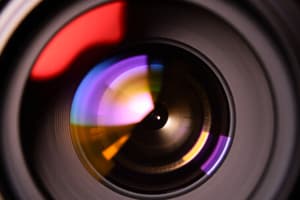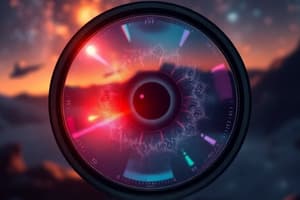Podcast
Questions and Answers
What type of lens is needed for a farsighted person?
What type of lens is needed for a farsighted person?
- Plano-concave lens
- Convergent lens (correct)
- Divergent lens
- Bifocal lens
In the context of lenses, what is the 'power' of a lens measured in?
In the context of lenses, what is the 'power' of a lens measured in?
- Dioptres (correct)
- Candela
- Lux
- Lumen
For a nearsighted person, what type of lens is typically required?
For a nearsighted person, what type of lens is typically required?
- Convex lens
- Plano-convex lens
- Concave lens (correct)
- Biconvex lens
What is the 'image distance' for the human eye according to the text?
What is the 'image distance' for the human eye according to the text?
What is the focal length of divergent glasses with a power of -6D?
What is the focal length of divergent glasses with a power of -6D?
What type of lens bends light so that the light rays come together to a point?
What type of lens bends light so that the light rays come together to a point?
What does h0 always represent in the context of lenses and images?
What does h0 always represent in the context of lenses and images?
Which type of lens forms both real and virtual images based on the position of the object?
Which type of lens forms both real and virtual images based on the position of the object?
How are convex lenses different from concave lenses?
How are convex lenses different from concave lenses?
What is the difference between a diverging and converging lens?
What is the difference between a diverging and converging lens?
In terms of thickness, how do convex and concave lenses differ?
In terms of thickness, how do convex and concave lenses differ?
What type of lens is classified as a diverging lens?
What type of lens is classified as a diverging lens?
What type of image is formed by a lens through the actual intersection of light rays from the object?
What type of image is formed by a lens through the actual intersection of light rays from the object?
Where should an object be located with respect to the focal point of a converging lens to act as a magnifying glass?
Where should an object be located with respect to the focal point of a converging lens to act as a magnifying glass?
What type of lens is thicker around the edges and thinner in the center?
What type of lens is thicker around the edges and thinner in the center?
In what situation do rays from the same point on an object appear to come from a much larger object due to bending by a lens?
In what situation do rays from the same point on an object appear to come from a much larger object due to bending by a lens?
What type of image formation occurs when no light rays reach the image location?
What type of image formation occurs when no light rays reach the image location?
How does a converging lens act when the object is farther away from the lens than one focal length?
How does a converging lens act when the object is farther away from the lens than one focal length?
Flashcards are hidden until you start studying
Study Notes
Lenses and Images
- An image is real if it is on the opposite side of the lens from where light is coming, and virtual if it is on the same side as the light source.
Optical Instruments: The Human Eye
- The human eye consists of a variable-geometry lens (crystalline) that produces a real image on the retina, which is transmitted to the brain via the optical nerve.
- The crystalline lens automatically adjusts itself so we can see objects clearly between infinity and a distance called the "near point" (about 25cm for a typical 20-year-old).
- The "image distance" in the human eye is approximately 2cm, which is the diameter of the eye.
Eyeglasses and Contact Lenses
- A farsighted person needs a convergent lens to correct their vision.
- A nearsighted person needs a divergent lens to correct their vision.
- The "power" of a lens is measured in dioptres: P = 1/f, where f is in meters.
Spherical Lenses
- A lens is an optical device that bends light in a specific way.
- A converging lens bends light so that the light rays come together to a point, forming real and virtual images.
- A diverging lens bends light so it spreads apart, forming only virtual images.
Convex Lenses
- Convex lenses are thicker in the center than at the edges.
- Convex lenses converge light rays, forming real and virtual images.
Concave Lenses
- Concave lenses are thicker at the edges and thinner in the center.
- Concave lenses diverge light rays, forming only virtual images that are erect and reduced.
Ray Tracing for Lenses
- Ray tracing is a method for locating the image formed by a lens.
- The convex lens forms different image types depending on the object's location with respect to the focal point.
Characteristics of Images
- A real image is formed by the actual intersection of light rays from the object.
- Real images can be projected on a surface.
- A virtual image is formed when rays from the same point on an object are bent by the lens so that they appear to come from a much larger object.
- A converging lens acts as a magnifying glass when the object is closer to the lens than one focal length.
- A diverging lens forms a virtual image that is right-side up.
- The magnification varies for single lenses, depending on the distance of the object from the lens.
The Lens Equation
- The lens equation is an alternative to ray tracing for locating the image formed by a lens.
Studying That Suits You
Use AI to generate personalized quizzes and flashcards to suit your learning preferences.





